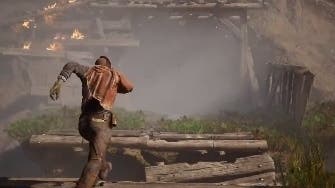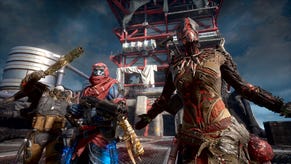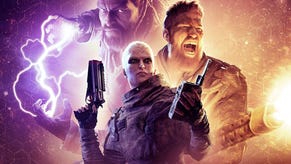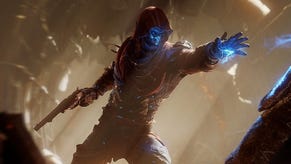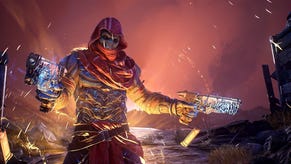Outriders dev explains all those pesky loading cutscenes
Leap of faith.
If you've been playing the Outriders demo since it came out last week, you may have picked up on an annoyance: loading cutscenes.
The third-person looter shooter game from People Can Fly (Bulletstorm, Gears of War: Judgment) plays a short cutscene whenever you want to move to a new area.
These cutscenes show everything from a character opening a door to climbing a ledge. They include a full fade to black opening before playing the cutscene, then another fade to black before you get back into the action.
These cutscenes sometimes border on the hilarious. One I noticed while playing saw my character perform a dramatic jump across a broken bridge:
It doesn't help that in these cutscenes your character magically ditches the armour you've just been wearing to show their face and hair. And then when you materialise on the other side, the armour is magically back on.
The issue is sometimes exacerbated by the prevalence of these cutscenes. There are parts of the demo, which revolves around the quest hub of Rift Town, where you can find yourself caught in a loading cutscene vortex as you move through different areas.
Clearly, these cutscenes are hiding background loading. In the clip I tweeted, you can see my character approach the gap in the bridge, then I press and hold square (I'm playing on PlayStation 5) to enter a new area. Then, we get the cutscene for the jump across. When the cutscene ends and I'm back in the action, I'm in this new area.
These are not seamless transitions. Video games have had more elegant, less immersion-breaking loading transitions for years (who can forget the slow shimmy through a tight gap before entering a new area?). But Outriders does things differently.
So, what's going on? I caught up with creative director Bartek Kmita, and lead designer Piotr Nowakowski from People Can Fly to find out.
As you'd expect, there is loading of the new area going on here. But there's another reason for this jarring transition: co-op.
Outriders can be played three-player co-op throughout the entire game. And without dedicated servers, Outriders needs to bring all players together when one wants to enter a new area. The game isn't able to have all players running around entirely different arenas at the same time.
"It started quite pragmatic, because we needed a system that would help us teleport the players and stream some other content to start to load the other arena," Kmita told me.
But why have cutscenes showing your character transition, performing banal actions such as opening doors, climbing ledges and jumping across chasms? After all, it's not like Outriders is the first co-op game to offer different arenas for players to explore at the same time. Last gen we had Destiny, and the gen before that we had Borderlands. There are many other examples, each with their own solutions for keeping co-op players seamlessly playing together in the virtual world.
Because of feedback during playtests, People Can Fly said. Initially, Outriders did not have these loading cutscenes. Instead, there was a simple fade-in and fade-out as all players were brought together. But some playtesters complained they were disoriented when they loaded into a new area. They didn't know where they had gone to. And so, the brief cutscenes showing your character physically moving to a new area were born.
"A good example is opening the door," Kmita said. "That was only because people in playtests said, 'oh, where am I? Why was I teleported?' So we needed to have these cutscenes. We couldn't have done it so manually you can go through the doors, because we have a multiplayer game that opens different problems for us."
Specifically on the jump cutscene I tweeted about, Nowakowski explained what's happening under the hood:
"I'm the person who's triggering the travel, so I want to jump to the other side and start a battle on the opposite side. Let's imagine one of my friends is next to the city, to Rift Town. The second one is travelling along the main path towards the enemies there. I cannot just go there and trigger three different areas, because it will not work in a game without dedicated servers.
"Second, if I will just trigger that transition, then the two others will be teleported. Then they will see, okay, where are we? Our idea - maybe it doesn't work exactly as we wanted - but the idea was, okay, show all the players what's happening, that we are jumping on the opposite side. So they see, okay!
"Same with the doors. Okay, we are entering that area. Our idea was to explain what's going on. Plus, we just need to gather all the players and not separate them in different areas."
The alternative solution would have been to automatically break groups of players up as they loaded into new areas in the game world, but People Can Fly was desperate to avoid that for Outriders.
"Without dedicated servers, our solution would be if two guys want to go to different parts, we have to separate them so they will not be able to play together. Because everyone needs to compute the AI and everything on their machine, we would have had to split the party," Kmita explained.
"I would like to have the door opening animation for two seconds, but still playing together with my friends, than just breaking apart through transmission. So we chose this solution. We understand it's not the best."
Kmita went on to suggest People Can Fly will look at perhaps improving these loading cutscenes so they're not so annoying, but it sounds unlikely that fundamental changes on this can be made. "We will try to look at this, but I can't promise a huge improvement can be done," he said.
These area transition cutscenes are most jarring when playing Outriders solo. When playing the game as a single-player story-driven looter shooter, which People Can Fly insists is a perfectly viable way to play the game, the structure of the game faces tough comparisons with other single-player story-driven action adventures that have for years now given players more elegant solutions to the loading new areas problem.
"In other games, where the transitions are more seamless, there is much more space, you [the player] need to run, drive or things like that," Kmita said.
"The streaming, the loading that is happening in the background in our levels is really intense. We just needed that solution to stream everything, to prepare the next arenas. And also to have the team together to play in a single arena, not split."
For its part, People Can Fly said the prevalence of the loading cutscenes reduces a bit the further you get into the game. In Rift Town, where quests, new areas and cutscenes are densely packed, this problem is keenly felt.
"[Rift Town] was the early stage of the game, so we experimented with plenty of solutions, quests in the middle of the arenas, things like that," Kmita said. "The two doors being in the same place, being close - from the structure point of view it's good because you are travelling, you have both doors. But from the point of, okay, cutscene here, cutscene there, so if I'm going from one to another there are a few cutscenes in a row.
"So there are some solutions that we noticed, and later in the game it's more consistent I will say. So less things like that are happening. Still, they are there. And we need to go with that and make it work as good as possible.
"I feel in Outriders we have quite a few interesting solutions from the design point of view. That one is not necessarily as good as we expected! I believe there are a few that are working really well and I am really proud of."
